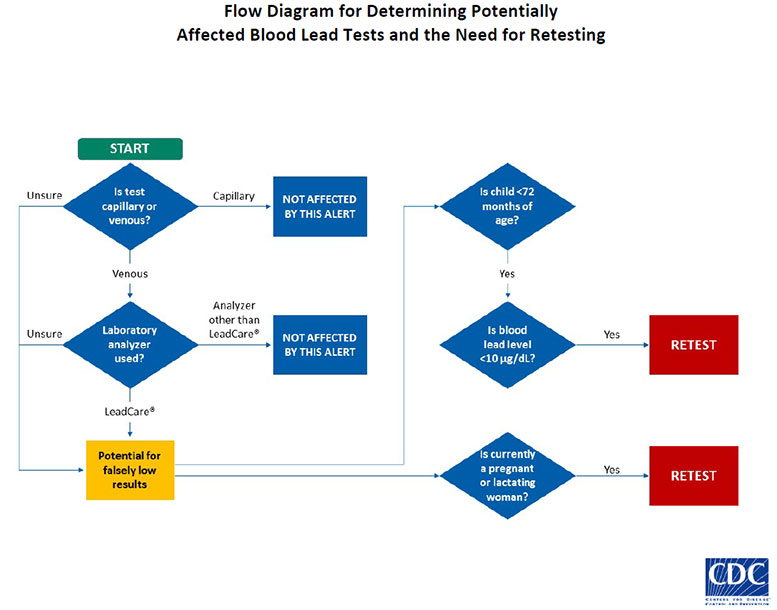Potential for Falsely Low Blood Lead Test Results from LeadCare® Analyzers
Distributed via the CDC Health Alert Network
May 17, 2017, 0900 ET (9:00 AM ET)
CDCHAN-00403
Summary
The U.S. Food and Drug Administration (FDA) has issued a safety communication warning about the use of Magellan Diagnostics’ LeadCare® analyzers (LeadCare, LeadCare II, LeadCare Ultra and LeadCare Plus) with venous blood samples because they might result in falsely low test results. FDA is now advising that Magellan Diagnostics’ LeadCare® analyzers should no longer be used with venous blood samples. The safety alert does not apply to capillary blood lead test results collected by fingerstick or heelstick. The purpose of this Health Advisory is to notify state and local health departments, healthcare providers, and laboratories about CDC’s re-testing guidance in light of the safety alert.
Background
CDC was contacted on April 24, 2017 by FDA requesting assistance in assessing the potential public health risk of a negative bias associated with Magellan’s lead testing systems. FDA is now warning that Magellan Diagnostics’ LeadCare® analyzers should no longer be used with venous blood samples due to the potential for falsely low test results. Not all blood lead tests are affected. Laboratory tests analyzed by inductively coupled plasma-mass spectrometry (ICP-MS) or graphite furnace atomic spectrometry (GFAAS) (also known as electrothermal atomic absorption spectrometry [ETAAS]) are not expected to have resulted in falsely low results. This safety alert applies to venous blood lead tests conducted using Magellan Diagnostics’ LeadCare® analyzers whether the patient is a child or an adult. At this time, the safety alert does not apply to capillary blood lead test results collected by fingerstick or heelstick using Magellan Diagnostics’ LeadCare® analyzers. Children are particularly vulnerable to lead exposure due to the effect on their developing brains and organ systems. CDC is working with public health officials throughout the United States to determine where the analyzers were used and which blood lead test results might be affected.
Recommendations
CDC recommends that healthcare providers re-test patients who:
1) are younger than 6 years (72 months) of age at the time of the alert (May 17, 2017) and
2) had a venous blood lead test result of less than 10 micrograms per deciliter (µg/dL) analyzed using a Magellan Diagnostics’ LeadCare® analyzer at an onsite (e.g., healthcare facility) or at an offsite laboratory.
CDC also recommends that healthcare providers re-test currently pregnant or lactating women who had a venous blood lead test performed using a Magellan Diagnostics’ LeadCare® analyzer.
CDC recommends parents discuss re-testing with their healthcare provider or health department to determine if their child’s blood should be re-tested.
If re-testing indicates blood lead levels in excess of the CDC reference level (www.cdc.gov/nceh/lead/acclpp/blood_lead_levels.htm), or the state or local action level, the healthcare provider or public health official should refer to CDC and/or local guidelines for appropriate follow-up action (www.cdc.gov/nceh/lead/acclpp/actions_blls.html).
Re-tests are not recommended if the provider is certain that analyzers other than those described by this Health Advisory were used to analyze the venous blood samples.
For future blood lead testing, healthcare providers and public health officials should:
- Send venous samples to Clinical Laboratory Improvement Amendments (CLIA)-compliant laboratories using inductively coupled plasma mass spectrometry (ICP-MS) or graphite furnace atomic absorption spectrometry (GFAAS) (also known as electrothermal atomic absorption spectrometry [ETAAS]) instruments.
- Send capillary samples to CLIA-compliant laboratories using any CLIA compliant analyzer including ICP-MS, GFAAS, or LeadCare® analyzers.

Click here to open Flow Chart (PDF)Cdc-pdf
For More Information
CDC’s Lead Poisoning Prevention Program: https://www.cdc.gov/nceh/lead/
CDC’s Lead and Multi-element Proficiency Program: https://www.cdc.gov/labstandards/lamp.html
Reference
FDA safety communication warning, May 17, 2017. Available at:
https://www.fda.gov/MedicalDevices/Safety/AlertsandNotices/ucm558733.htmExternal
The Centers for Disease Control and Prevention (CDC) protects people’s health and safety by preventing and controlling diseases and injuries; enhances health decisions by providing credible information on critical health issues; and promotes healthy living through strong partnerships with local, national and international organizations.
Department of Health and Human Services
HAN Message Types
- Health Alert: Conveys the highest level of importance; warrants immediate action or attention.
- Health Advisory: Provides important information for a specific incident or situation; may not require immediate action.
- Health Update: Provides updated information regarding an incident or situation; unlikely to require immediate action.
- Info Service: Provides general information that is not necessarily considered to be of an emergent nature.
###
This message was distributed to state and local health officers, state and local epidemiologists, state and local laboratory directors, public information officers, HAN coordinators, and clinician organizations.
###

